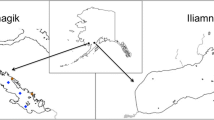Summary
In laboratory experiments, we tested the hypothesis that by living in larger shoals, juvenile threespine (Gasterosteus aculeatus) and blackspotted (G. wheatlandi) sticklebacks lower their risk of being parasitized by the crustacean ectoparasite Argulus canadensis. An increase in shoal size resulted in a lower average number of attacks received by individual fish, but had no negative effect on the attack performance (attack rate and attack success) of the parasites. In addition, more fish formed shoals and shoal sizes were larger in the presence of parasites. We conclude that ectoparasitism may have been a strong selective factor in the evolution of social behaviour in juvenile sticklebacks.
Similar content being viewed by others
References
Alexander RD (1974) The evolution of social behavior. Ann Rev Ecol Syst 5:325–383
Bond CE (1979) Biology of fishes. Saunders, Philadelphia
Brown CR, Brown MB (1986) Ectoparasitism as a cost of coloniality in cliff swallows (Hirundo pyrrhonota). Ecology 67:1206–1218
Cusack R, Cone DK (1986) A review of parasites as vectors of viral and bacterial diseases of fish. J Fish Diseases 9:169–171
Duncan P, Vigne N (1979) The effect of group size in horses on the rate of attacks by blood-sucking flies. Anim Behav 27:623–625
FitzGerald GJ (1983) The reproductive ecology and behavior of three sympatric sticklebacks (Gasterosteidae) in a saltmarsh. Biol Behav 8:67–79
Foster WA, Treherne HE (1981) Evidence for the dilution effect in the selfish herd from fish predation on a marine insect. Nature 293:466–467
Freeland WJ (1977) Blood-sucking flies and primate polyspecific associations. Nature 269:801–802
Freeland WJ (1979) Primate social groups as biological islands. Ecology 60:719–728
Godin J-G (1986) Antipredator function of shoaling in teleost fishes: a selective review. Nat Can 113:241–250
Guthrie JF, Kroger RL (1974) Schooling habits of injured and parasitized menhaden. Ecology 55:208–210
Hoogland JL (1979) Aggression, ectoparasitism, and other possible costs of prairie dog (Sciuridae, Cynomys spp.) coloniality. Behaviour 69:1–35
Hoogland JL, Sherman PW (1976) Advantages and disadvantages of bank swallow (Riparia riparia) coloniality. Ecol Monogr 46:33–58
Jarman PJ (1982) Prospects for interspecific comparison in sociobiology. In: King's College, Sociobiology group, Cambridge (eds) Current problems in sociobiology. University Press, Cambridge, pp 323–342
Keenleyside MHA (1979) Diversity and adaptation in fish behaviour. Springer, New York
Moore J, Simberloff D, Freehling M (1988) Relationships between bobwhite quail social-group size and intestinal helminth parasitism. Am Nat 131:22–32
Pitcher TJ (1986) Functions of shoaling behaviour in teleosts. In: Pitcher TJ (ed) The behaviour of teleost fishes. Croom Helm, London, pp 294–337
Poulin R, FitzGerald GJ (1987) The potential of parasitism in the structuring of a salt marsh stickleback community. Can J Zool 65:2793–2798
Poulin R, FitzGerald GJ (1988) Water temperature, vertical distribution, and risk of ectoparasitism in juvenile sticklebacks. Can J Zool 66:2002–2005
Poulin R, FitzGerald GJ (1989) Early life histories of three sympatric sticklebacks in a salt marsh. J Fish Biol (in press)
Reed A, Moisan G (1971) The Spartina tidal marshes of the St. Lawrence estuary and their importance to aquatic birds. Nat Can 98:902–922
Rutberg AT (1987) Horse fly harassment and the social behavior of feral ponies. Ethology 75:145–154
Ward G, FitzGerald GJ (1983) Macrobenthic abundance and distribution in tidal pools of a Québec salt marsh. Can J Zool 61:1071–1085
Worgan JP, Fitzgerald GJ (1981) Diel activity and diet of three sympatric sticklebacks in tidal salt marsh pools. Can J Zool 59:2375–2379
Author information
Authors and Affiliations
Rights and permissions
About this article
Cite this article
Poulin, R., FitzGerald, G.J. Shoaling as an anti-ectoparasite mechanism in juvenile sticklebacks (Gasterosteus spp.). Behav Ecol Sociobiol 24, 251–255 (1989). https://doi.org/10.1007/BF00295205
Received:
Accepted:
Issue Date:
DOI: https://doi.org/10.1007/BF00295205




